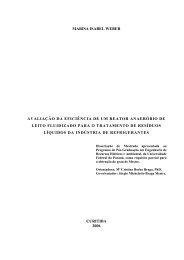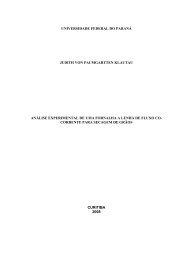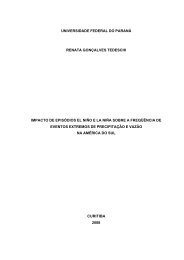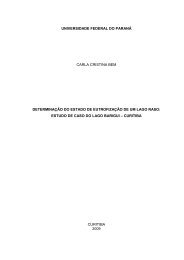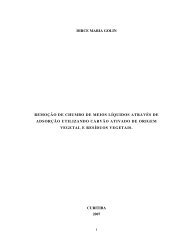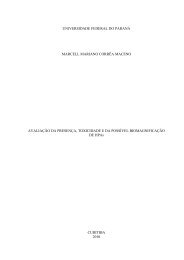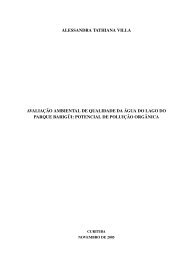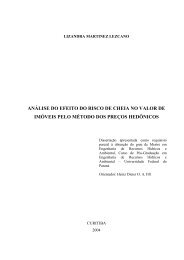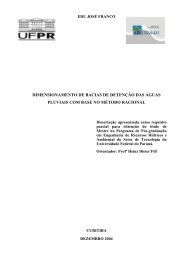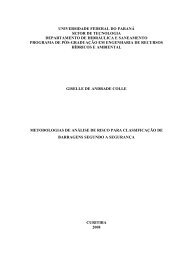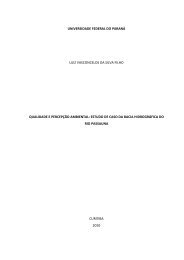Modelagem Física e Computacional de um Escoamento Fluvial
Modelagem Física e Computacional de um Escoamento Fluvial
Modelagem Física e Computacional de um Escoamento Fluvial
You also want an ePaper? Increase the reach of your titles
YUMPU automatically turns print PDFs into web optimized ePapers that Google loves.
Proce<strong>de</strong>ndo-se a <strong>de</strong>composição da equação (2.6) nas direções x, y e z e<br />
substituindo-se a força <strong>de</strong> superfície P pelas suas componentes obtém-se:<br />
<br />
∂u<br />
∂u ∂u<br />
ρ + u∂u + v + w = Fx −<br />
∂t ∂x ∂y ∂z<br />
∂p<br />
∂x +<br />
<br />
∂τxx<br />
∂x<br />
<br />
∂v<br />
∂v ∂v<br />
ρ + u∂v + v + w = Fy −<br />
∂t ∂x ∂y ∂z<br />
∂p<br />
∂y +<br />
<br />
∂τxy<br />
∂x<br />
<br />
∂w<br />
∂w ∂w<br />
ρ + u∂w + v + w = Fz −<br />
∂t ∂x ∂y ∂z<br />
∂p<br />
∂z +<br />
<br />
∂τxz<br />
∂x<br />
+ ∂τxy<br />
∂y<br />
+ ∂τyy<br />
∂y<br />
+ ∂τyz<br />
∂y<br />
7<br />
<br />
∂τxz<br />
+ ;<br />
∂z<br />
<br />
∂τyz<br />
+ ; (2.10)<br />
∂z<br />
<br />
∂τzz<br />
+ .<br />
∂z<br />
Inserindo-se as equações constitutivas (2.8) e (2.9) no lugar das tensões normais<br />
e tangenciais, são obtidas as equações <strong>de</strong> Navier-Stokes para fluido compressível com<br />
viscosida<strong>de</strong> variável:<br />
ρ<br />
ρ<br />
ρ<br />
∂u<br />
∂t<br />
∂v<br />
∂t<br />
∂w<br />
∂t<br />
<br />
∂u ∂u<br />
+ u∂u + v + w =Fx −<br />
∂x ∂y ∂z<br />
∂p<br />
<br />
∂<br />
+ µ 2<br />
∂x ∂x<br />
∂u 2<br />
−<br />
∂x 3 ∇ · <br />
V +<br />
<br />
∂ ∂u ∂v<br />
µ + +<br />
∂y ∂y ∂x<br />
∂<br />
<br />
∂w ∂u<br />
µ + ;<br />
∂z ∂x ∂z<br />
<br />
∂v ∂v<br />
+ u∂v + v + w =Fy −<br />
∂x ∂y ∂z<br />
∂p<br />
<br />
∂<br />
+ µ 2<br />
∂y ∂y<br />
∂v 2<br />
−<br />
∂y 3 ∇ · <br />
V +<br />
<br />
∂ ∂u ∂v<br />
µ + +<br />
∂x ∂y ∂x<br />
∂<br />
<br />
∂v ∂w<br />
µ + ; (2.11)<br />
∂z ∂z ∂y<br />
<br />
∂w ∂w<br />
+ u∂w + v + w =Fz −<br />
∂x ∂y ∂z<br />
∂p<br />
<br />
∂<br />
+ µ 2<br />
∂z ∂z<br />
∂w 2<br />
−<br />
∂z 3 ∇ · <br />
V +<br />
<br />
∂ ∂v ∂w<br />
µ + +<br />
∂y ∂z ∂y<br />
∂<br />
<br />
∂w ∂u<br />
µ + .<br />
∂x ∂x ∂z<br />
Em <strong>um</strong> escoamento incompressível, que correspon<strong>de</strong> ao caso estudado neste tra-<br />
balho, o divergente da velocida<strong>de</strong> é nulo e as equações (2.11) po<strong>de</strong>m ser escritas sem o<br />
termo 2<br />
3 ∇ · V . Se a viscosida<strong>de</strong> for consi<strong>de</strong>rada constante, o que geralmente ocorre em <strong>um</strong><br />
escoamento incompressível pois as variações da temperatura T são pequenas e a viscosi-<br />
da<strong>de</strong> é basicamente apenas função da temperatura, as equações <strong>de</strong> Navier-Stokes po<strong>de</strong>m



